The Cornelian cherry have been expectant for the better part of January. Round buds plump and peppering the branches. Look closely at the beginning of February and you see the dark casings that hold them tightly, ruptured and revealing a seam of gold. I return daily as they gather momentum, passing the witch hazel, which is already perfuming the exit from the garden, and crossing the track to the ditch where I have planted a grove of Cornus mas. Here, staggered on the steep slopes, they step from one side to the other in a group of half a dozen to frame the passage the bridge makes across the water.
I am eager for life this far into winter and the cornus budburst happens at the same time that the snowdrops claim these last two weeks of February and as they pass the baton to the primroses. I have combined the three here deliberately and en masse, so that the crossing becomes an event to focus the near horizon. With the waning skeletons of the garden now behind me, the energy in the cornus help start to move things forward. One at a time, but quickly gathering pace, the darkness in the bare branches is eclipsed by a myriad tiny cadmium yellow flowers of invigorating intensity. Each bud contains up to twenty tiny flowers that are as much stamen as petal, but the accumulation of thousands make the trees appear to be spangled with an inner light. With the snowdrops and primroses they are a magnet for early pollinators.

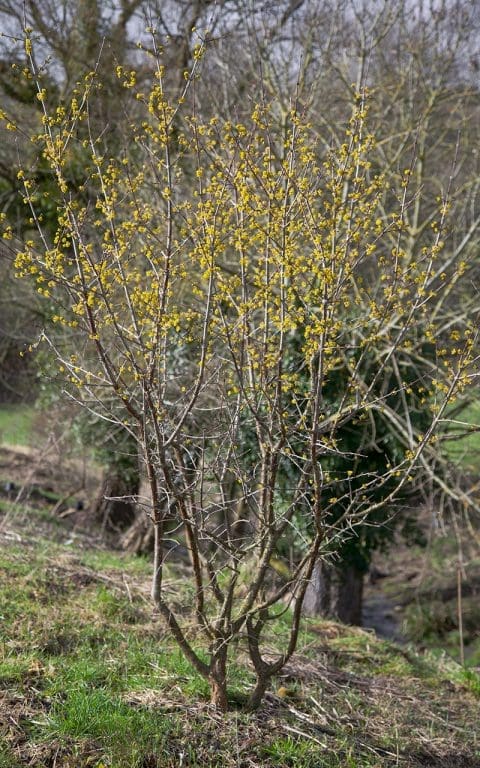
The cornus are young and are currently not much taller than myself. I brought them in three years ago as root-balled specimens to replace the brambly hedge that had swallowed this little ravine. Cleared and opened up again the banks have been host to meadowsweet, willowherb and other marsh-loving perennials. Though they are very slow growers – creating a wood so dense it sinks in water and is highly prized for making tools – I hope that eventually they will grow to about the height of a hawthorn and touch in places where I have planted them close enough together. In time, flaking limbs, branching low and twisting give the trees winter character – a contorted, Japanese quality – and me the opportunity of raising the canopy by pruning out the understory. Something to look forward to and deliberate upon whilst doing so.
I watched for the first couple of years to find the places where the cornus might be at home, because I knew they would not take the wetness that our native Cornus sanguinea is happy with. Although widespread in Southern Europe and Southwestern Asia, their preference is for ground that holds moisture and doesn’t dry out entirely in the summer, but that never gets waterlogged. It has been an education to see how they have already shown me where they like to be. I hit water when planting two, the springs in the bank not being visible above ground. Since the land is steeply sloping I felt it would be free-draining even with running water, and so I went with it. Sure enough, now that the trees have had two summers to settle in, I can see that, given a damp position they are already growing more lushly than those on the higher, dryer ground. Only one has suffered from being planted in a boggy pocket, and seemed slowly to be going backwards, although it has started to shoot from the base, so may be making its own adjustments. Time will tell as the conditions express themselves further in growth, but for now all of them are happy.

My mission now is to extend the snowdrop trail that I have growing under the nearby hazel to follow their canopies. The snowdrops will be sure to let me know where the ground is too wet, but they are likely to enjoy the drying effect that the roots of the cornus will have in the summer when in growth. The trees will be in flower for the best part of a month, so I have underplanted them with Tenby daffodils which will pick up as the snowdrops wane and the cornus dim.
In summer, the Cornelian cherry is easy on the eye in a natural setting, for its leaves are not unlike our native dogwood. Late in summer, in a warm position where the fruit can ripen, you will see that they are hung with small drops of ruby red, which are highly prized by birds. Though too tart for us to eat raw, they have been an important food source for over 7000 years in Greece, where they are still made into jam and raki. As autumn comes the foliage colours russet and gently red and, by the time the leaves drop, you will already see the embryonic buds, ready and waiting for the time when we gardeners are hungry for signs of life.
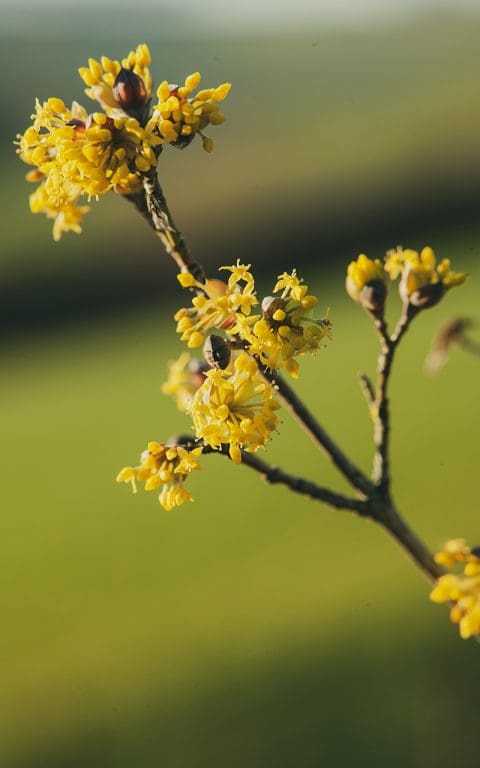
Words: Dan Pearson / Photographs: Huw Morgan
Published 16 February 2019
Yellow breaks with winter. Soft catkins streaming in the hazel. Brightly gold and blinking celandines studding the sunny banks. They are shiny and light reflecting and open with spring sunshine. As strong as any colour we have seen for weeks and welcome for it.
There is more to come, and in rapid succession, now that spring is with us. The first primroses in the hollows and dandelions pressed tight in grass that is rapidly flushing. Daffodils in their hosts, pumping up the volume and forsythia, of course, at which point I begin to question the colour, for yellow has to be handled carefully.
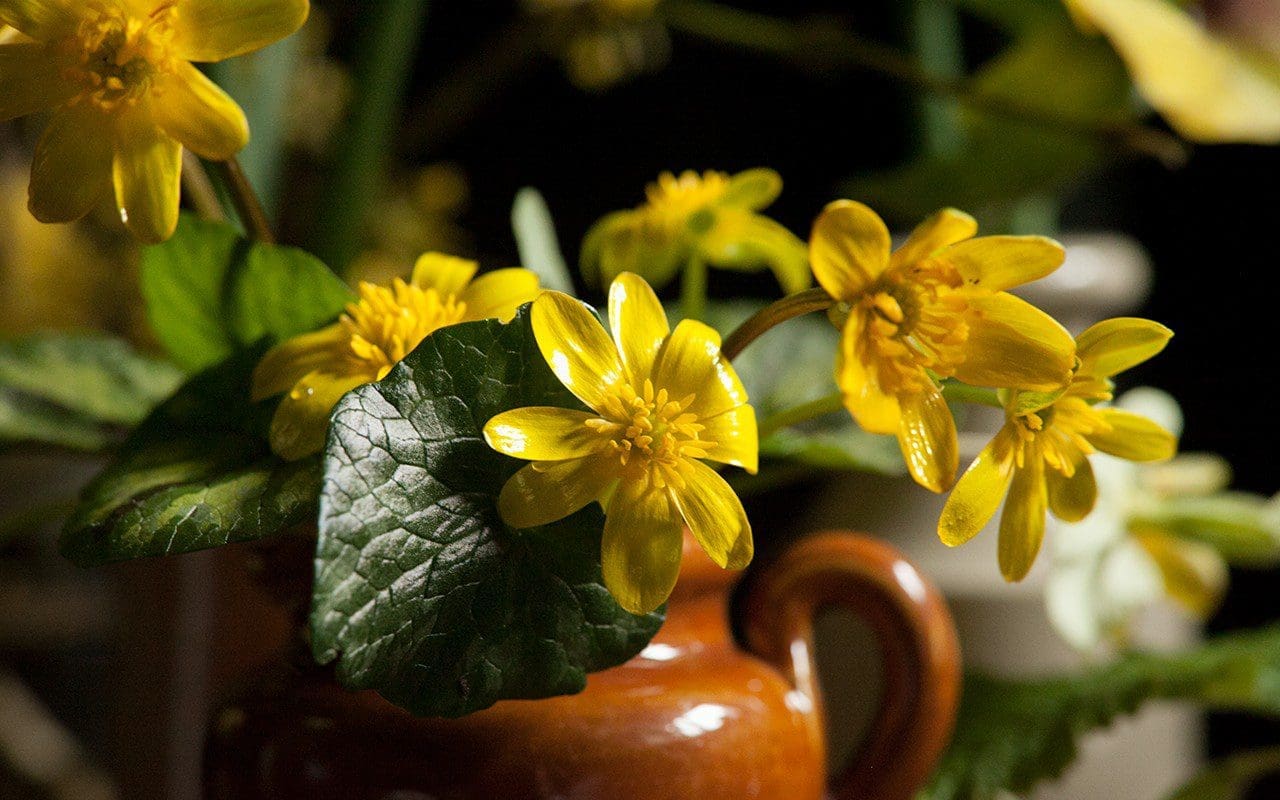 Lesser Celandine – Ranunculus ficaria
Lesser Celandine – Ranunculus ficaria
In all my years of designing it is always yellow that clients most often have difficulty with. ‘I really don’t like it’. ‘I don’t want to see it in the garden’. ‘Only in very small amounts’. Strong language which points to the fact that it prompts a reaction. Colour theory suggests the yellow wavelength is relatively long and essentially stimulating. The stimulus being emotional and one that is optimistic, making it the strongest colour psychologically. Yellow is said to be a colour of confidence, self-esteem and emotional strength. It is a colour that is both friendly and creative, but too much of it, or the wrong shade, can make you queasy, depressed or even turn you mad.
Whether I entirely believe in the thinking is a moot point, but I have found it to be true that yellow is a positive force when used judiciously. My first border as a teenager was yellow. I experimented with quantity and quality and by contrasting it with magenta and purple, it’s opposites. Today I weave it throughout the garden, using it for its ability to break with melancholy; a flash of Welsh poppy amongst ferns or a carefully selected greenish-yellow hellebore lighting a shaded corner.
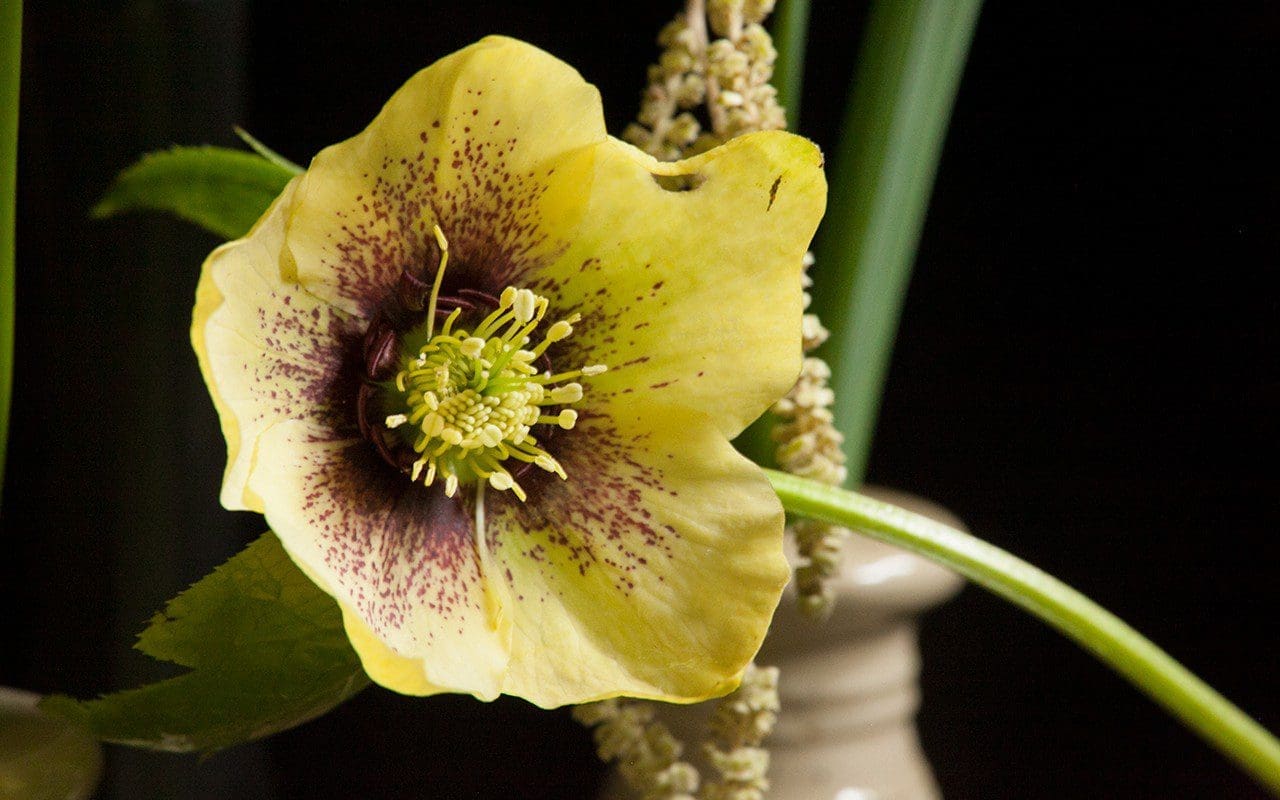 Helleborus x hybridus Ashwood Selection Primrose Shades Spotted
Helleborus x hybridus Ashwood Selection Primrose Shades Spotted
I remember talking to the textile designer, Susan Collier, about the use of yellow in her garden in Stockwell. She had repeated the tall, sulphur-yellow Thalictrum flavum ssp. glaucum throughout the planting and explained how she used it to draw the eye through the garden. ‘Yellow in textile design is extraordinarily persistent. It is noisy, but it lifts the heart. It causes the eye to wander, as the eye always returns to yellow.’
At this time of year, I am happy to see it, but prefer yellow in dashes and dots and smatterings. I will use Cornus mas, the Cornelian cherry, rather than forsythia, and have planted a little grove that will arch over the ditch in time and mingle with a stand of hazel. The fattening buds broke a fortnight ago, just as the hazel was losing its freshness. Ultimately, over time, my widely spaced shrubs will grow to the size of a hawthorn, the cadmium yellow flowers, more stamen than petal, creating a spangled cage of colour, rather than the airless weight of gold you get with forsythia.
We have started splitting the primroses along the ditch too. I hope they will colonise the ground beneath the Cornus mas. I have a hundred of the Tenby daffodil, our native Narcissus obvallaris, to scatter amongst them. The flowers are gold, but they are small and nicely proportioned. Used in small quantity and widely spaced to avoid an obvious flare, they will bring the yellow of the cornus to earth.
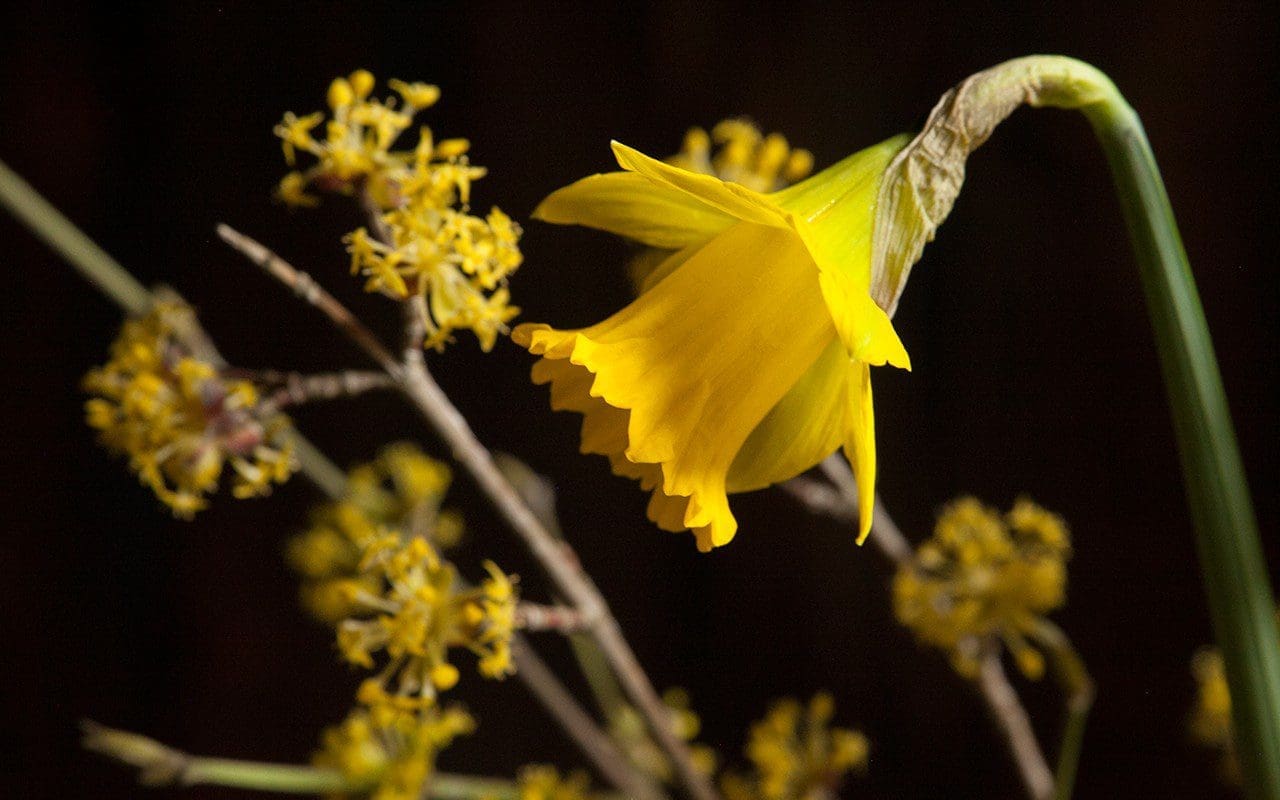 Narcissus obvallaris with Cornus mas (Cornelian cherry)
Narcissus obvallaris with Cornus mas (Cornelian cherry)
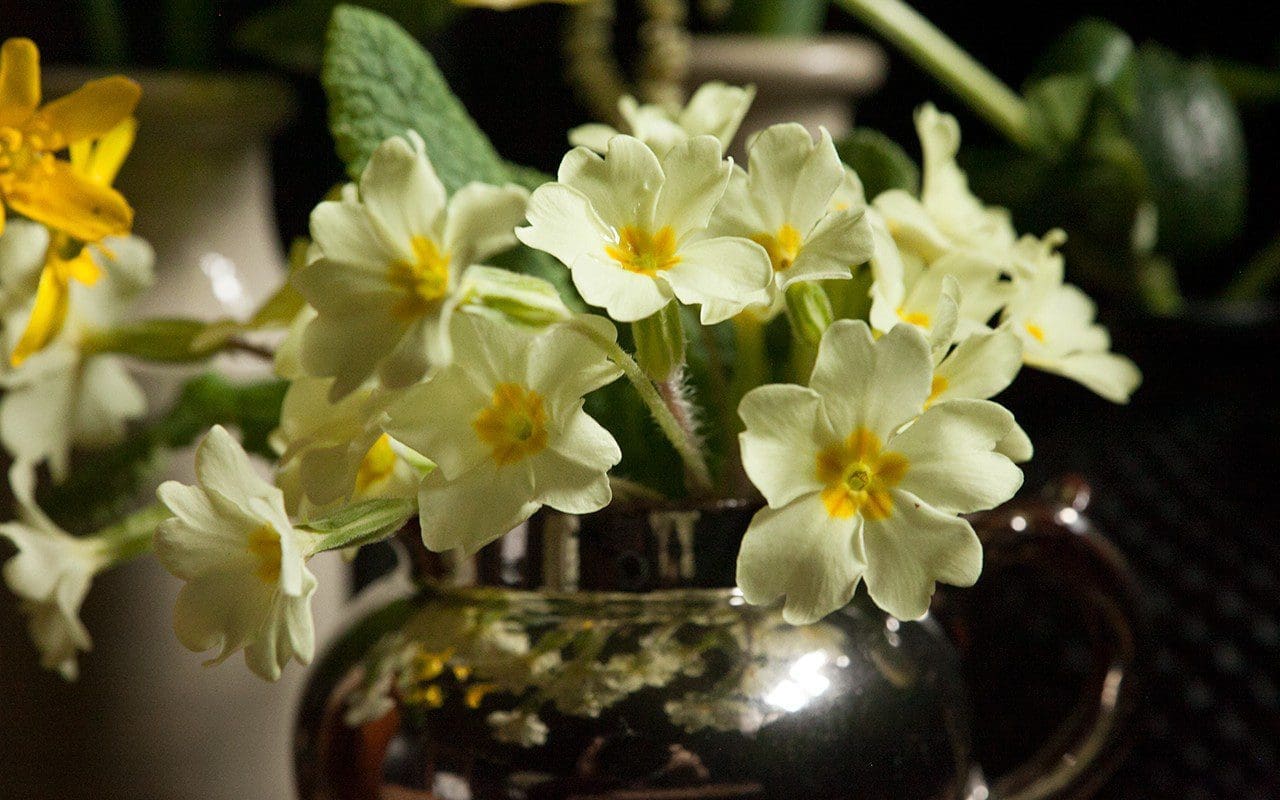 Primrose – Primula vulgaris
Primrose – Primula vulgaris
After several years of experimenting with narcissus, I have found that they are always best when used lightly and with the stronger yellows used as highlights amongst those that are paler. N. bulbocodium ‘Spoirot’, a delightful pale hoop-petticoat daffodil is first to flower here and a firm favourite. I have grown them in pans this year to verify the variety, but will plant them on the steep bank in front of the house where, next spring, they will tremble in the westerly winds.
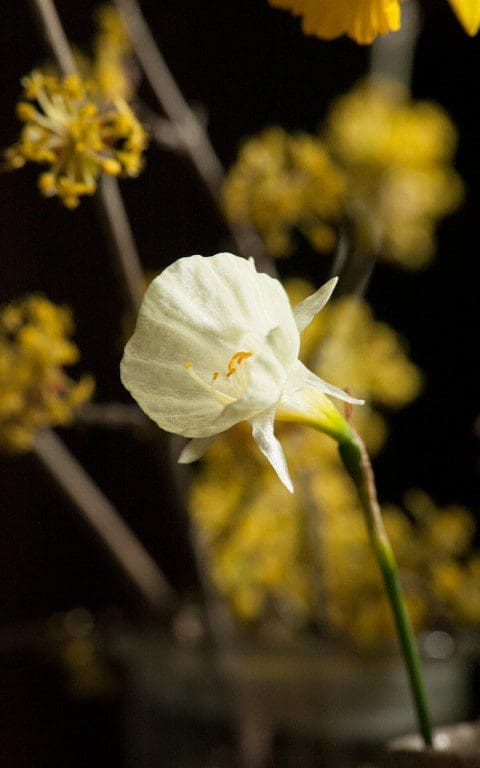 Narcissus bulbocodium ‘Spoirot’
Narcissus bulbocodium ‘Spoirot’
The very first of the Narcissus x odorus and Narcissus pallidiflorus are also out today, braving a week of overcast skies and cold rain. The N. pallidiflorus were a gift from Beth Chatto. She had been gifted them in turn by Cedric Morris, who had collected the bulbs on one of his expeditions to Europe. The flowers are a pale, primrose yellow, the trumpet slightly darker, and are distinguished by the fact that they face joyously upwards, unlike their downward-facing cousins.
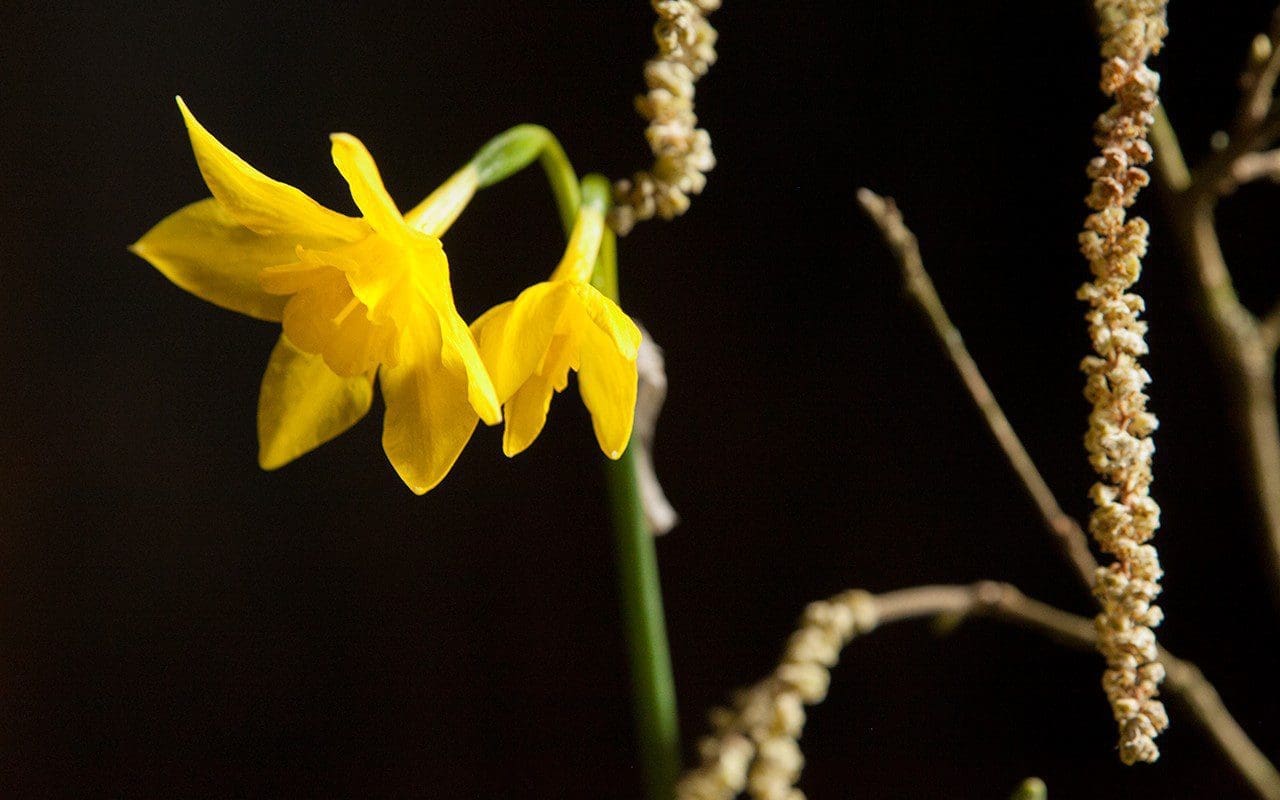 Narcissus x odorus
Narcissus x odorus
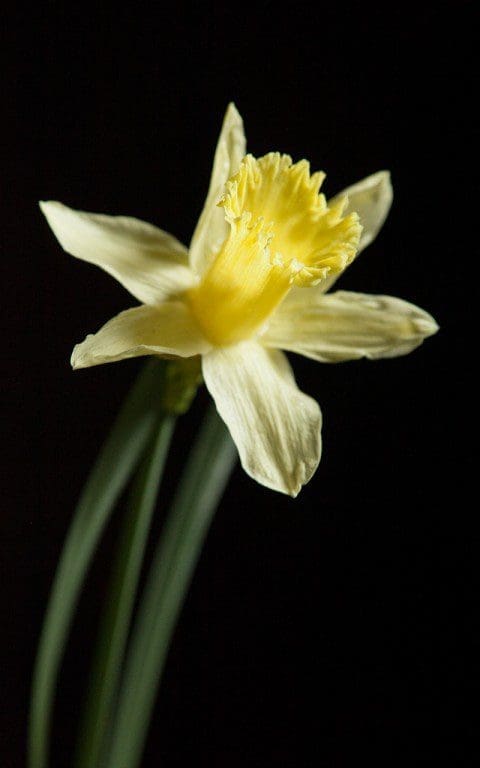 Narcissus pallidiflorus
Narcissus pallidiflorus
Our other native daffodil Narcissus pseudonarcissus has a trumpet the same gold as N. obvallaris, but with petals the pale lemon hue of N. pallidiflorus. It has an altogether lighter feeling than many of the named hybrids for this gradation of colour. We were thrilled to see a huge wild colony of them in the woods last weekend, spilling from high up on the banks, the mother colony scattering her offspring in little satellites. This is how they look best, in stops and starts and concentrations. I am slowly planting drifts along the stream edge and up through a new hazel coppice that will be useful in the future. A move that feels right for now, with all the energy and awakening of this new season.
 Narcissus pseudonarcissus (top), Narcissus obvallaris (bottom)
Narcissus pseudonarcissus (top), Narcissus obvallaris (bottom)
Words: Dan Pearson / Photographs: Huw Morgan
We are sorry but the page you are looking for does not exist. You could return to the homepage